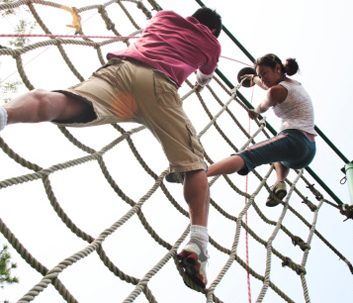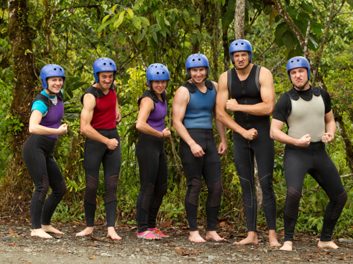
The thrill of obstacle racing
If you want to start obstacle racing, you might need a motto.
“Do – don’t think!” was the one that got 29-year-old Alex Aidar through her first obstacle race this spring.
“That’s what it took to keep going at certain points,” the Torontonian says of the Tough Mudder experience she had with six friends – but all the pain was worth it in the end. “It’s been a month and I’m still stoked,” she says.
Obstacle racing has been gaining momentum for the past couple of years-especially among those who want to push their workouts to the next level. With runs like the Spartan series, War Hero, Tough Mudder and even The Zombie Race and Zombie Survivor (dodging the undead certainly counts as a hurdle) it’s never been easier to test your fitness and have a good time doing it.
If these challenges sound like a fitness obstacle you’re ready to tackle, here’s what you need to know before stepping-or plunging boldly-into the mud.

Prepare for an uphill battle
When they signed up for the Tough Mudder run at Moonstone Ski Resort in Coldwater, Ontario, Aidar and her friends didn’t know what to expect. “We knew there would be hills between obstacles, but we didn’t anticipate how many – or how steep – they would be,” she says. “We also didn’t anticipate just how much they would throw us off our game mentally.”
Aidar is not the only one surprised by the challenge that hill running presents. Many racers are so concerned with working on the strength needed to heave themselves over 12-foot walls, they forget about the terrain and endurance aspects. “For a lot of people, the inclines can be more difficult than the actual obstacles,” says Damir Mulalic, owner of Calgary-based Empowerment Personal Training, “but you can pretty much guarantee it is going to be part of any obstacle race out there.”
Mulalic, who runs outdoor boot camps leading up to Calgary’s Spartan Sprint each year, recommends finding an intimidating hill in your neighborhood, running to the top, performing 10 burpies, then returning to the bottom. Your goal: complete as many runs as possible in 30 minutes. “Physically, you can adapt relatively quickly to hill running. A few weeks of a simple workout like this and you will be fine,” he says. “It’s getting used to the mental struggle that comes along with it that will help you keep going on race day.”

Two (or 10) are better than one
Yes, obstacle races are ultimately about testing strength and endurance beyond a regular city run, but the second biggest focus is definitely on fun. “These races are meant to be done as a team,” says 29-year-old Vancouver native, Jessica Dunn.
Dunn, who took part in the 2012 Tough Mudder in Whistler, B.C. as part of an eight-person team (five of whom are firefighters) believes it’s the team spirit that actually keeps people coming back year after year. “You don’t leave anyone behind and that’s a great feeling,” she says. It’s also a relief to split the “burpie penalties” in the Spartan series, which is the punishment for not getting all your team members through an obstacle (it wouldn’t be fun to do that alone).
According to Zach Schieck, a command staff at Toronto’s military obstacle training facility, The O Course Crucible, external support is the key to success in any race. “Join a team that is dedicated to training for the event or, at the very least, invite a small group of supportive and active friends to come out and cheer you on,” he says. “During tough times, camaraderie will prevail. Work as a team and you will overcome anything in your path.”

Do your homework
When it comes to obstacle and mud runs, training for the race environment is crucial. “Many of these events have race heats starting all day long, so a lot of runners will face the midday heat during the summer,” explains Jonathan Campbell, co-owner of Calgary’s 2110 Fitness and a veteran mud runner himself. Campbell suggests racers adjust their training to reflect the time of day they will be competing, so their bodies acclimatize to those conditions and they will be able to perform without any risk of shock.
Campbell also emphasizes the importance of studying the terrain, obstacles and distance of your race ahead of time. No course is the same and it’s rare that the distance is exactly as advertised, so it’s best to be over-prepared. “I recently ran a Spartan Sprint in Montana that was scheduled for three-plus miles, but in reality it was more like five,” Campbell says. “That messed with a lot of the runners.”
Tip: With the abundance of social media outlets today, race directors are able to communicate with participants as the courses are being built. By following their Twitter and Facebook feeds, you can gain all sorts of insights and know what to expect going in.

Gear Up
A lot of racers are concerned about what brand or style of shoes will best serve them in an obstacle race, but the best idea is to wear the shoes that you regularly train in and that work well for your stride. Not only is race day not a great time to try out new kicks in terms of performance, but you also need to consider that your shoes may not be coming home with you. “Wear what you will be comfortable in and be prepared to get rid of your shoes post-race,” Campbell says.
The same thing goes for your workout gear. Ripped clothing is par for the course, as is being caked in mud, so be prepared to toss your goods in the charity bin (many of the races collect runners’ clothing to be washed and donated) or at least bring a garbage bag to transport your gear to the washing machine.
That being said, costumes are often encouraged, so don’t be afraid to sport your team colours and have fun with it.
Related:
• Cross-training for runners
• How to be a better runner
• Fitness trend: Boot camp
